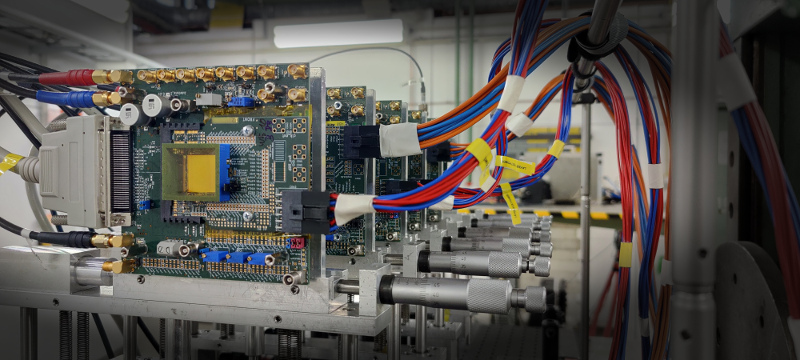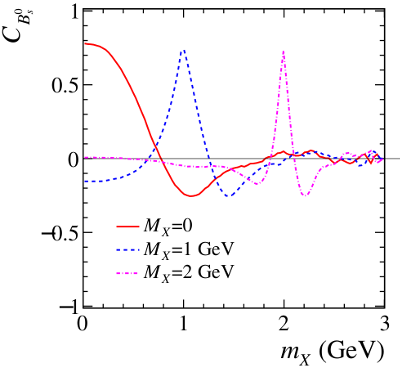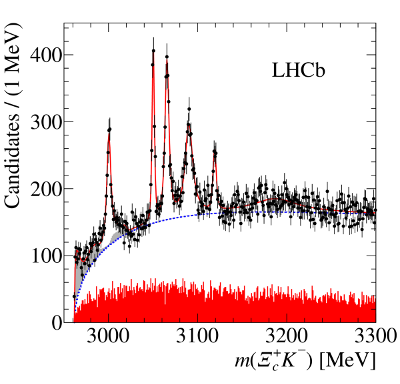Open Projects for Master and Bachelor Theses
If you are interested to join our group and work on one of these projects, please contact Sebastian Neubert: neubert (at) hiskp.uni-bonn.de
Tracking at high luminosity at LHCb
Keywords: tracking, SciFi, MightyTracker
One of the goals of LHCb is to measure a multitude of particles with a high precision at a high rate. One of the key requirements for this is efficient and fast tracking. The future upgrades of LHCb will need a reevaluation of the current tracking parameters. The focus of this analysis should be the future MightyTracker, which is planned to be installed around the beampipe in the SciFi detector.
Development of a chip calibration for MightyPix sensor

Keywords: Pixel, HVMPAS, MightyTracker, Silicon Radiation Damage
The future MightyTracker of the LHCb experiment will use up to 3m2 of silicon pixel chips. For this it is important to develop an extensive testing procedure. The chip will be developed over the next years and a reliable procedure to calibrate the chip response will be a vital tool.
Using Bs oscillations to probe invisible particles

- Plot from https://arxiv.org/abs/1911.12729
Keywords: data analysis, partial reconstruction
Using a novel technique, the oscillation frequency of Bs meson mixing, which is very well measured by LHCb, can be used to constrain the mass of missing particles in partially-reconstructed decays. The technique works best with heavier missing particles, such as neutral kaons or neutrons. It also has applications in searches for Bs decays with exotic weakly-interacting particles in the final state. This project will explore the feasibility of using this technique with existing data collected by LHCb.
Search for exotic particles with strangeness in Lambdab decays
Keywords: exotic hadrons, pentaquarks, angular moments
This project will investigate the angular structure of the decay Lambdab->Jpsi Lambda Phi. Here tetraquarks are expected to show up in the Jpsi phi system and pentaquarks with strangeness in the Jpsi Lambda system.
Glueballs in Hadronic B decays
Keywords: hadron spectroscopy. exotic hadrons, glueballs
Glueballs are hadronic states, which do not have any valence quark contents, but are purely composed of gluonic field excitations. Finding such objects is a challenge, since the lightest predicted glueball is expected to mix with scalar mesons. In this project we plan to perform a combined analysis of several datasets with sophisticated amplitude models. The project will involve close collaboration with theory colleagues.
A reference library for resonance amplitudes
Keywords: hadron spectroscopy, resonances, amplitude analysis, theory, software library
A constant recurrent theme in hadron spectroscopy is the correct parameterisation of scattering and decay amplitudes. The particle data group is publishing a good review on this topic https://pdg.lbl.gov/2019/reviews/rpp2019-rev-resonances.pdf . However, although the important features which need to be taken into account are generally well understood theoretically, most analysis will use a custom computer code for the implementation. In many cases simplified parameterisations are then used in practice, which may or may not be justified on a case by case basis. It is often difficult for a published paper to evaluate the impact the choice of parameterisation has on the results.
In this project a reference implementation of hadronic resonances will be developed and published as an open source library. The emphasize is not on computational efficiency and we do not expect that this library be used universally in amplitude analysis. Instead it should define appropriate interfaces and allow the comparison between different lineshapes. It should also provide examples of the impact, which certain simplifications in the amplitudes can have on extracted results. The library should be developed in close cooperation with theorists and be subjected to rigorous review by the community.
Developing a Knowledge Graph for LHCb data analysis
Keywords: analysis preservation, open data, FAIR data, machine learning, knowledge management
An open problem in the area of reproducible research and analysis preservation is to document a data analysis (or a collection of analyses) in a rigorous way, in particular in a way that can be handled by machines. There often is a lot of tacit knowledge, which the analysts posses but which cannot easily be recorded in a paper. Such hidden knowledge makes it difficult to communicate the contents and meaning of a data analysis to other people in enough detail, that they can actually reproduce the results. This difficulty has to be overcome in order to make analyses and their associated digital research products available to a larger open community.
Knowledge graphs are a concept from representation theory, which allows the formal description of entities and their relations. [https://arxiv.org/pdf/2003.02320.pdf]
Typical physics data has the advantage that it is often already quite formalized and so should lend itself well to building knowledge graphs. An example concept used in the LHCb data processing software if the “Decay Tree” - a data structure describing a cascade of decays of unstable particles. What is currently missing is an ontology and semantics to capture the contents of what such a DecayTree actually means in a well defined manner. A simple application of this idea might be that given a set of decay trees implemented in the LHCb stripping or HLT, one could infer missing decays, which would not be selected but could be allowed.
A recent development in the field is the combination of knowledge graphs with the methods from neural computing. In particular knowledge graphs can be embedded in vector spaces, which makes it easier to manipulate them. This is a topic researched in Bonn and might open interesting new fields of research.
Literature:
https://persagen.com/files/misc/Wang2017Knowledge.pdf
The goal of this project is to create a prototype of a knowledge graph, describing LHCb data analyses, starting from the basic concept of the DecayTree. Part of this will be do create an ontology, which captures the semantics, i.e. the “Meaning” of the concepts used to assemble a DecayTree.
There is a possible collaborative opportunity with the Machine Learning and Artificial Intelligence Lab Bonn, where the connection between Knowledge Graphs and Neural Networks is being researched.
Exploring Normalising Flow Models for use in HEP
Keywords: Machine learning, statistical inference
Normalising Flows are models, which are similar to neural networks but implement an important feature: they are designed such that they can be inverted. The layers of the network represent simple transformations operating on a simple probability density function. The composition of many of such transformations allow to generate arbitrary pdfs. Normalising Flows therefore belong to the class of generative models. But they are uniquely well defined in contrast to other models such as Generative Adversarial Networks and more suitable to quantitative analysis. This makes them promising candidates for machine learning in physics.
Literature: https://arxiv.org/abs/1912.02762
In this project we will explore the use of a normalizing flow to parametrize an experimental distribution.
Ongoing and Completed Projects
A new LHCb Masterclass (Physik Lehramt)

- Five Omega_c states [PRL118(2017)182001]
Keywords: outreach, Masterclass, spectroscopy
The International Masterclasses are an important outreach event, where highschool students get invited to experience the work of a physicist for one day. A central part of this day is a data analysis exercise using real LHCb data.
In this project a new exercise will be developed, which demonstrates how we search for new hadrons at the LHC.
Bachelor thesis by Stefan Harst
Tracking in a future LHCb Upgrade
Keywords: tracking, SciFi, MightyTracker
One of the goals of LHCb is to measure a multitude of particles with a high precision at a high rate.This project investigates the expected performance of the proposed Hybrid tracker and evaluates different design options.
Masterthesis by Hannah Schmitz
The pentaquarks as molecules: key signatures
Keywords: pentaquarks
The most popular model to explain the pentaquarks observed by LHCb is a molecular model. In this type of model the pentaquarks are composed of two hadrons - a meson and a baryon - in a shallow bound state. For the observed pentaquarks the Sigmac-D system is the prime candidate for such a composition. If the hypothesis were true we expect significant coupling of the pentaquarks to the corresponding Sigmac-D final state.
This analysis will perform a pentaquark search in Sigmac++D- from Lambda_b decays,
Masterthesis by Abhay Mehta
